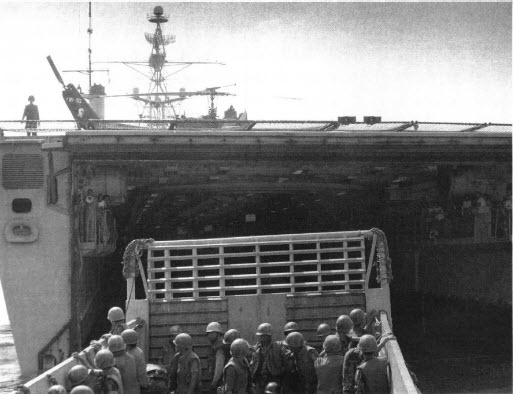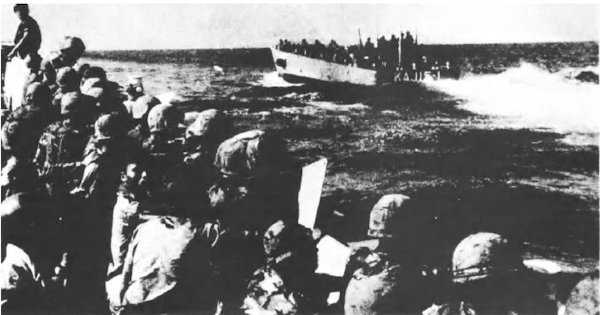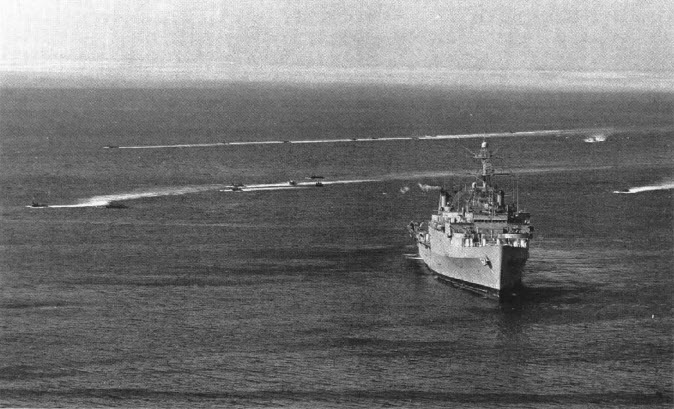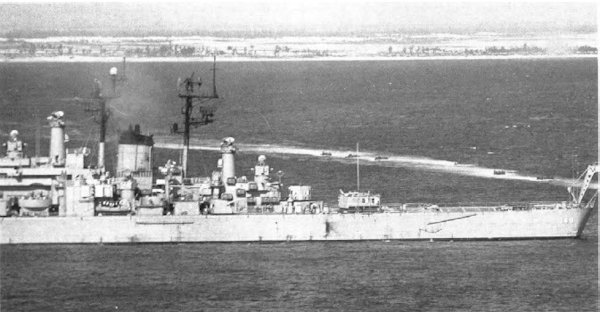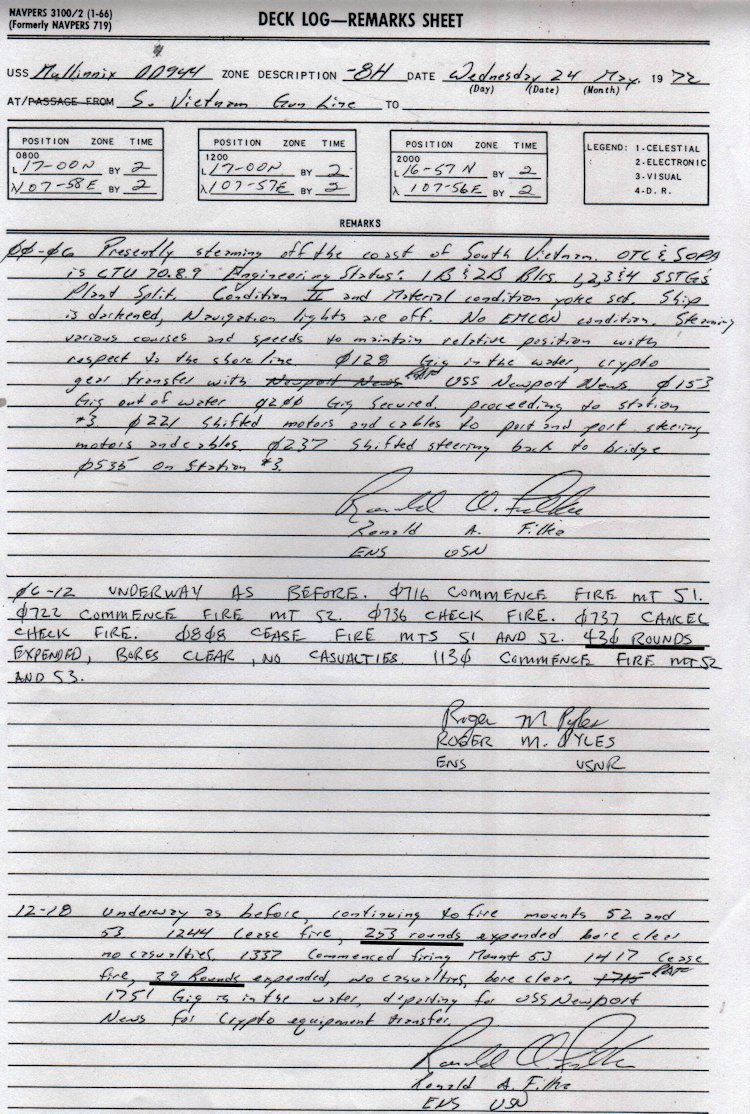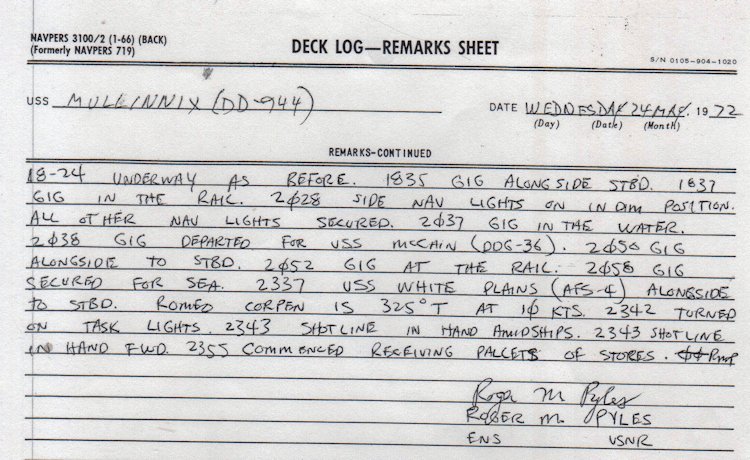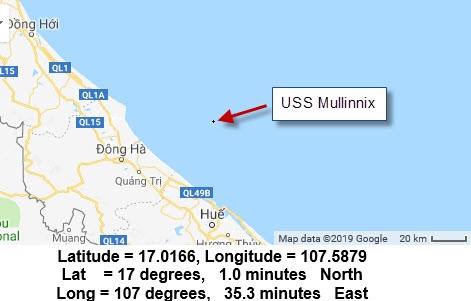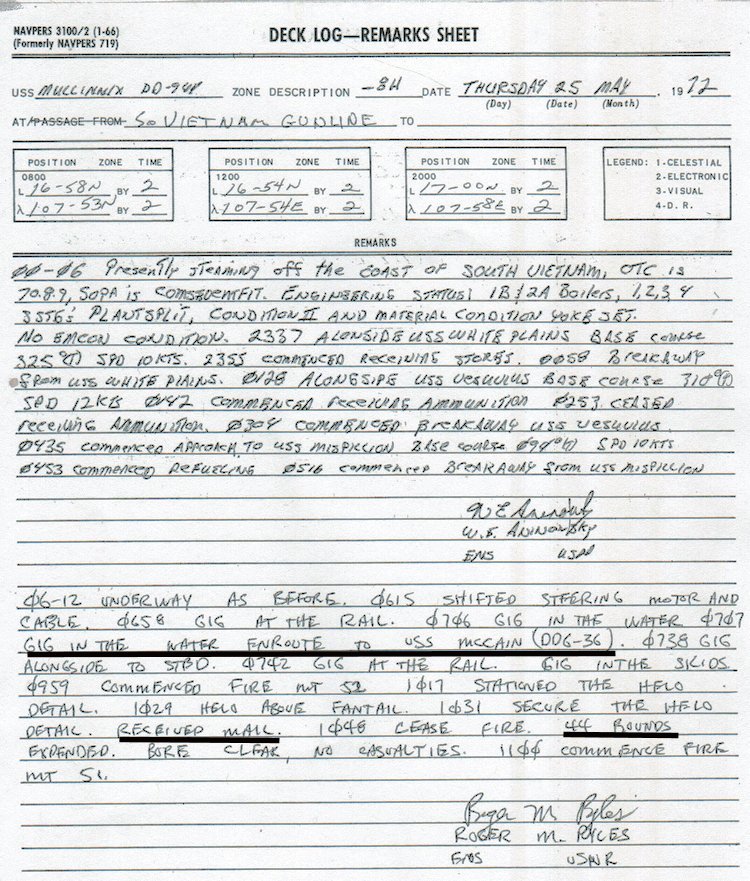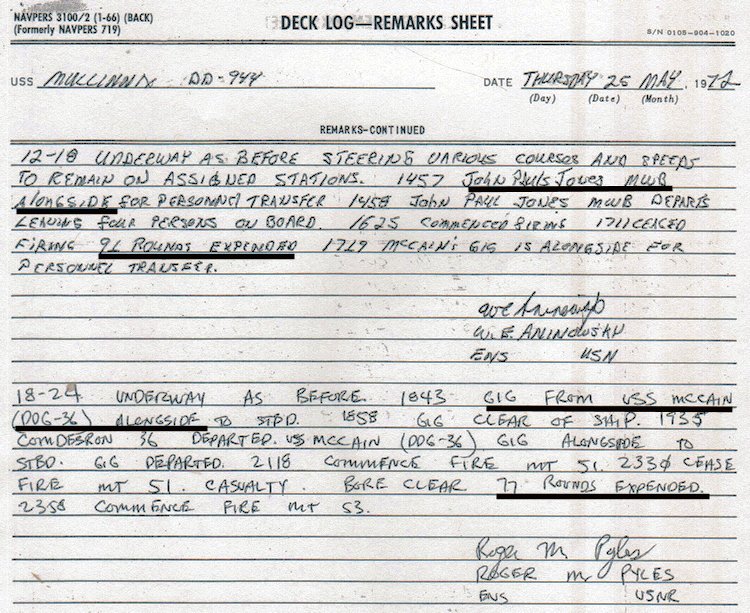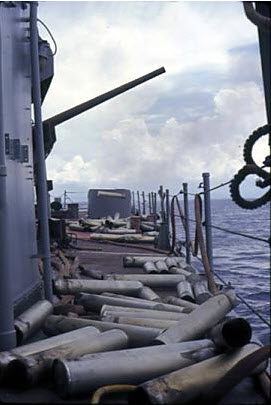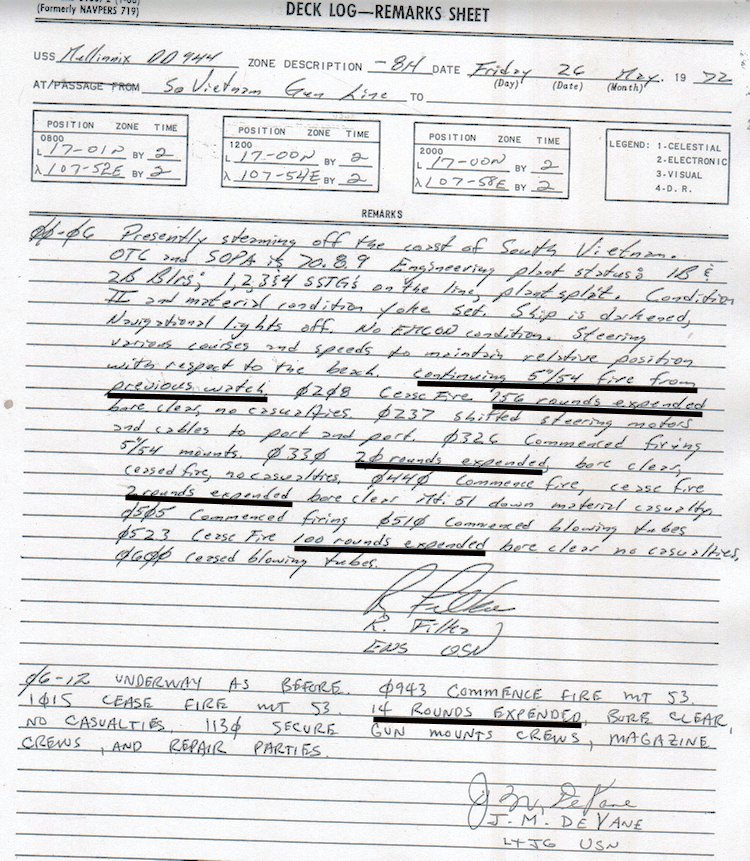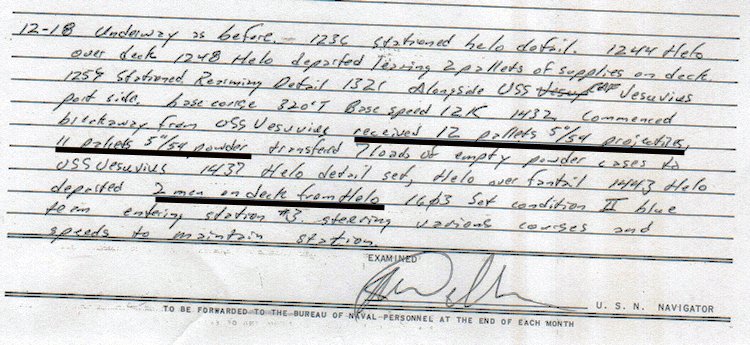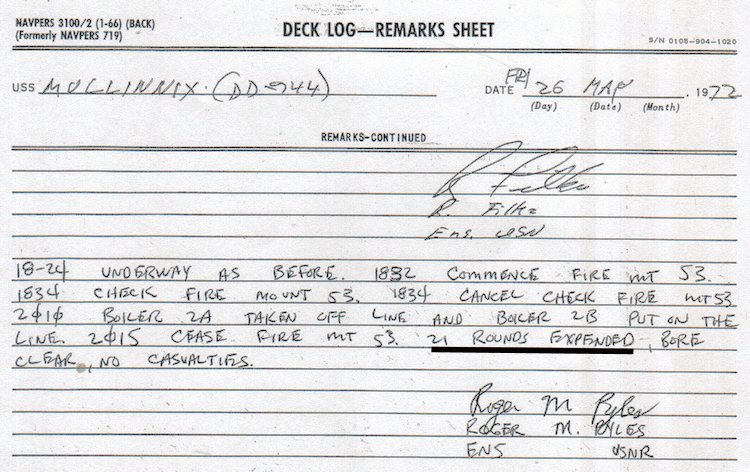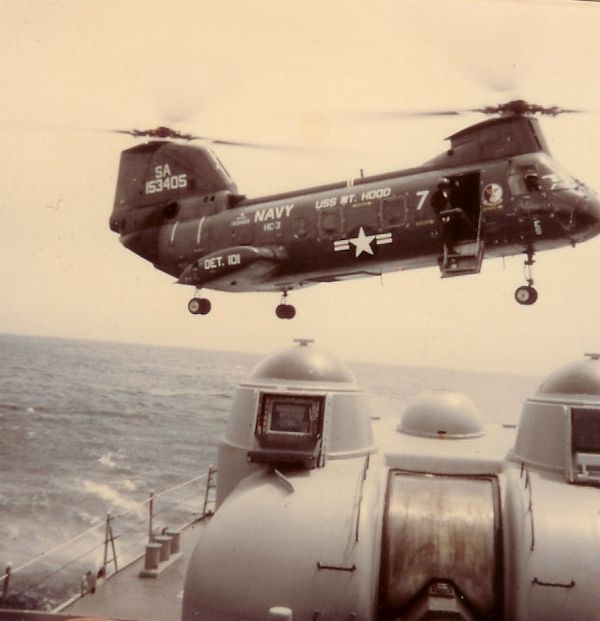


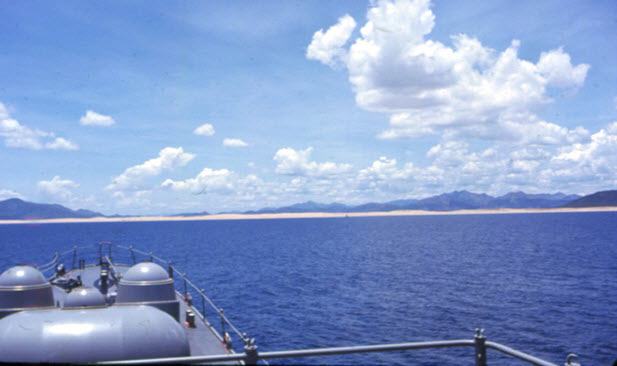
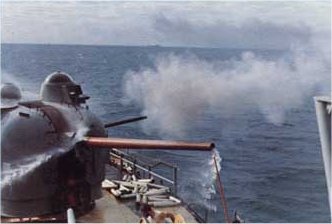  | The Last Gun Ship - History of USS Mullinnix DD-944Excerpt From The Historic Novelby Frank A. Wood |
| ...Just beyond the edge of the camp, there was a large crater protected by a makeshift wooden barrier. The last structures closet to the crater had been severely blast-damaged. Windows were shattered, doors hung drunkenly open, and a section of roof was burnt down to the rafters, open to the sky.
The enemy had left these in an attempt to camouflage their current activities. They had built a series of connecting buildings that were half submerged in the ground, covering virtually all the exposed surfaces with felled trees. The remaining forest canopy cast heavy shadows over the structures, allowing them to blend into nothingness. South Vietnamese patrols had spotted activity a few nights before and had been monitoring the level of activity to determine the best time to call for fire to maximize the destruction. When naval surface fire support is available and the general tactical situation permits its use, naval firepower can provide large volumes of devastating, immediately available, and instantly responsive fire support to combat forces operating near coastal waters as well as support land operations. The decision was made not to use spotting rounds so as to maximize the surprise. The spotters would simply make any necessary corrections during the actual fire mission. Fuses were set on MT51 ammunition to allow vicinity-detonation approximately fifteen feet above the ground. MT52 and MT53’s ammo was set for impact detonation. As the first shells began to impact, geysers of mud and dirt rifled into the air, impacting the metal rooftops, making a sound like a coal scuttle emptying itself across a marble floor. Panting and out of breath, VC officers started yelling, lifting their voices above the bellowing of the explosions and the chattering of the impacting debris. Within moments, a dozen fires were blazing. Flames spreading across the dried camouflaging timber laying on the roofs, the gushing white-hot light threw dancing, grotesque shadows across the concert walls of the structures. More shells rained down, cracking loudly as they slammed into buildings and the surrounding landscape. Every few seconds there was a larger detonation as the 6” and 8” from the cruisers USS Oklahoma City and USS Newport News found their marks. The enemy could feel the heat blasts and the terror as they mistakenly choose to stay inside the half submerged structures. A sudden huge explosion and soldiers in one of the structures were rocked off their feet, falling to the floor in a tangle. From outside, the dull explosions of more shells shook the air within their fortress. They could actually feel the edges of their sanity begin to fray like rotting tissue. Mullinnix and her sister-ships continued to fire their shells into the growing pall of smoke and flame. Within thirty minutes more than two-hundred rounds had been fired into the flaming compound. The concentration of supplies, ammunition, and fuel accelerated the destruction as roofs disintegrated with internal explosions. The flaming debris from the fires was carried aloft on the gusting winds, tossing firebrands across the forest canopy. The ongoing destruction could be seen for miles around as boiling clouds of smoke and flame rose like a fuming maelstrom hundreds of feet into the air. At ground level, plies of concrete and timber blocked many of the structures’ exists, making it impossible for the VC to escape the flames. Their ears rang with each explosion outside, the sound magnified by their concrete enclosures. They could feel the heat as well, pouring in through the vents arranged around the buildings’ roof lines. Flames from the raging fires poured in, hot white and flickering, looking for new fuel. The spitting roar of the fires and the booming arrival of additional shells increased in force, so loud that Charlie could feel the last standing concrete walls vibrate with Richter-scale like intensity. Their world had been set on fire. The camp a seething cauldron of boiling flame and whirling smoke. From the south end to the northern edge of the jungle, from the western entrance to the eastern exits, it was all alight. All of it consumed by fires that grew larger even as the Marine spotters radioed, “Cease Fire, Cease Fire!” |
  | Stars & StripesAllies Pour It On Enemy Near HueFriday, May 23, 1972 |
| Saigon (AP) – Allied bombers and naval gunfire smashed a tank-led North Vietnamese attack on the "Street Without Joy" north of Hue at dawn Sunday but fighting was continuing at mid-afternoon, military sources reported.
Meantime, the South Vietnamese drive to break the 45-day siege of An Loc appeared to have slowed again, although advance elements of the relief force were reported within a mile of their goal. The An Loc push was being impeded by Communist harassing attacks on government troops on Highway 13 to the rear of the spearhead, field reports said. The U.S. command reported, meanwhile, that air strikes in Quang Tri Province in the last two days had damaged or destroyed a variety of Communist equipment, including four big 130mm artillery guns, a surface-to-air missile and a missile transporter. The command said the air strikes destroyed one and damaged three of the guns, the biggest in Hanoi's arsenal with a range of 17 miles. They have been used with devastating effect against South Vietnamese forces in the current offensive. The bombing report for the 24-hour period ending early Sunday also included two other artillery guns, four tanks, 29 trucks and several antiaircraft guns destroyed or damaged. Military sources said a company-sized North Vietnamese force using tanks launched the pre-dawn attack on the populated coastal strip called "Street Without Joy," crossing the My Chanh River in one of the most serious breaches yet of the key defense line 22 miles north of Hue. The attackers routed a provincial militia unit from its position and had partially encircled a South Vietnamese Marine outpost before the air strikes and artillery were brought to bear on them about daybreak. Field reports said at least 70 Communists were killed by the strikes. There was no report of South Vietnamese casualties. The air and artillery were believed to have broken the back of the attack, and most of the surviving North Vietnamese had been driven back, the reports said. By midafternoon, reinforcements still had not reached the Marine position but the situation was "easing up," military officers were quoted as saying. |
  | Stars & StripesCruisers: Deadly Accurate Mobile ArtilleryFriday, May 23, 1972By Mort Rosenblum |
| ABOARD U.S.S. NEWPORT NEWS (AP) – Cruisers, the giant dreadnaughts that lay out to sea and rain devastation with sniper precision, are back to stardom after three decades of walk-on parts.
Five U.S. cruisers off Vietnam fire hundreds of explosive rounds daily above Hue. They are the Americans' only offensive surface artillery left in the war. Three swept past Haiphong two weeks ago, with batteries booming, in the first multicruiser raid since World War II, following with darkness strikes just like in the movies they show on board. But a lot has changed on the massive gunships since their heyday of the early 1940s. Seamen with peace bands around shaggy hair smoke marijuana below decks. Gunners in the turret tell visitors they are ashamed of killing. Young officers express frustration at the war. But even the great B52s can't match the power and deadly accuracy of the cruisers. The three batteries of triple eight-inch guns on the Newport News can deliver rapid-fire death for hours on end. Old timers admit the gung-ho has been replaced by a more reflective approach among the crew. Still, the jobs get done. "These ships are damned effective," said Capt. Walter Zartman of the Newport News, a naval officer since World War II. The Haiphong strike, for instance, "went like clockwork... Everyone performed magnificently." In Vietnam, the cruisers mainly use their six and eight-inch batteries for close support of South Vietnamese ground forces, blasting at enemy positions and supply lines. They work with forward spotters in light planes, and ground directors, sometimes coordinating with bombers and tactical aircraft. Occasionally, their roles mingle, in bizarre combinations. The Providence, for example, chased a tank down a road with its six-inch guns until, after about 40 rounds, the tank crew fled to a hut. The building immediately took a direct hit and disintegrated. Then spotters called an air strike on the abandoned tank which was blasted away by a rocket. Why, navy men were asked, wasn't the tank just rocketed in the first place? "We each have jobs to do..." was the reply. Newport News is the biggest gunship in the world, but even the smaller cruisers, all with secondary batteries and some with missiles, can devastate a village in minutes. "And I don't like it," said Signalman Steve Schlemmer, 21, of Placentia, Calif., aboard the Providence, typical of a new breed of sailor who follows orders but asks himself why. "I don't think we have the right to change the landscape of these people, like blasting Olympicsized swimming pools in their backyards." The "Newpy News" is a 7l7 foot-long city, with its own television station, newspaper, helicopter pad, 28-bed hospital and dental clinic. Normal population is 1,200. Steam turbines deliver 120,000 horsepower to the four propellers, generating enough electricity for a city of 40,000 and distilling 60,000 gallons of water. The ship displaces 21,000 tons. These vessels make a large target for counterbatteries on shore, and sometimes they take as many hostile rounds as they deliver. "If you get shot at, you get shot at," said Lt. Ronald Wools of Terre Haute, Ind., on the Providence, who spent time dodging fire at closer range on Vietnamese rivers. "It doesn't make a damned bit of difference." Strangers on the Newport News, dizzy from the thundering boom of the eight-inchers, forget their vulnerability until counterfire just off the stern splashes water on the fantail. All the ship can do is steam away at 33 knots, maneuvering artfully, straining to get out of range while the men on decks huddle in flak jackets and helmets, nervously eyeing the air. Enemy aircraft are even more dangerous, but apart from a MIG which recently tore up the turret on the destroyer Higbee, U.S. ships have been relatively lucky. And they are well defended. "Actually, I think the morale of the boys has been better since they have gone into combat, doing what they were trained to do," observed on senior cruiser officer. Many of the crew agree, but others say they were far happier when the Newport News was lying at Norfolk, or the Providence at San Diego, going out for occasional good will or holiday training cruises. Cruisers have been used for shelling the Vietnam coast off and on during the past five years, playing subordinate role to ground troops and air power. Now they have taken over a leading position. "What we have is just a piece of mobile artillery," said Rear Adm. W. Haley Rogers, commander of the 11th Cruiser-Destroyer Group, and, he said, they are good at their classic strike role. As one crewman said, with a resigned look: "Whatever we're doing, we're here. I thought we were going to get out of this war. But here we are." |
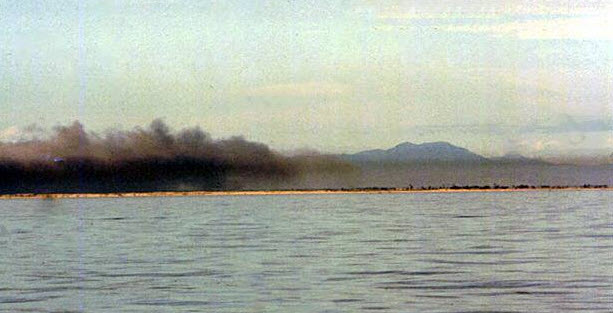

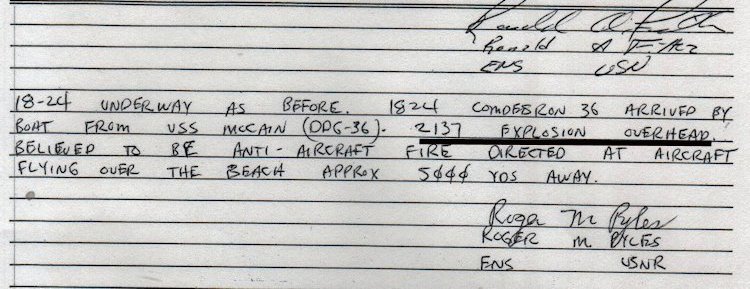
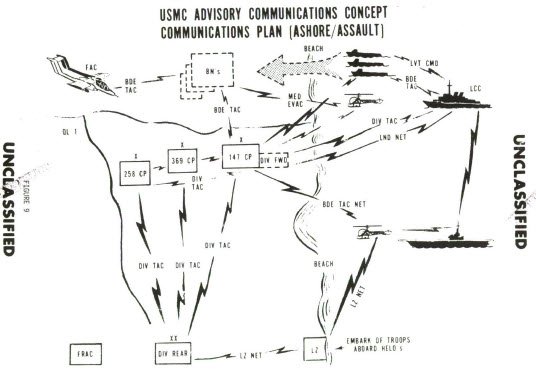
  | Stars & StripesViets Preparing For Crucial Hue BattleThursday, May 25, 1972by Donald Bremner |
| HUE, Vietnam (UPI) – As the days dwindle to what many fear are a precious few, a tough South Vietnamese commander is quietly building up the defenses of Hue.
Whether by design or necessity, the North Vietnamese have given the new commander, Lt. Gen. Ngo Quang Truong, breathing space to reestablish government positions to the south and west of Hue. Truong, highly regarded by the American advisers for his military ability and his non-involvement in politics, was appointed May 3 as commander of Military Region I which contains South Vietnam's five northern provinces. President Nguyen Van Thieu fired Truong's predecessor, Lt. Gen. Hoang Xuan Lam, after the Communists completed their conquest of the northernmost province of Quang Tri. Since then Truong has sent a successful raiding party into Quang Tri, stabilized northern defensive positions along the My Chanh River 20 miles north of Hue and reoccupied at least temporarily artillery bases Bastogne, 12 miles southwest of Hue and Rakkasan, 15 miles due west of Hue. The last two government pushes were to set up what officials call a "ring of steel" designed to keep Communist guns outside of artillery range of the old imperial capital. Truong also has visited many of the troops in and outside of Hue, quietly building confidence or instilling fear -whichever he deems necessary for government forces to hold the line. Hue is a prize to both Saigon and Hanoi. In Saigon, a senior diplomat said, "whoever wins the battle for Hue can sit down at the Paris peace talks with a vital trump card. "Hue is now the key to the war." Today, perhaps two-thirds of the city"s pre-invasion population of 150,000 has fled to Da Nang, 50 miles to the south, and beyond. Immediately after the collapse of Quang Tri, near panic swept Hue. The narrow highway heading into the city was choked with refugees from the north. Frightened South Vietnamese soldiers fired their rifles in front of trucks to make the vehicles stop so they could get rides. The river of refugees could not be curbed. But what had to be stopped quickly was the soldiers, hundreds of them, who had left their units to flee south. One of the first orders given by Truong was for all soldiers to return to their units or face death by firing squad. A wall of sandbags was built on the north side of the river for executions. The soldiers stopped running. Military sources believe the Communists have four divisions, some 40,000 men, designated for the assault on Hue. The South Vietnamese have some of their best troops manning the Hue defenses. They include two Marine regiments, major parts of an airborne division and the 1st Inf. Div. Some American advisers admit if these units fall to the Communists, then Vietnamization has failed. The North Vietnamese forces are deployed north of the My Chanh 20 miles north of Hue and 12 to 15 miles to the west and southwest of the city. The eastern sector is relatively secure, with only a short distance between the city and the South China Sea. Only 10 miles southeast of Hue is Phu Bai base, where the largest contingent of American troops north of Da Nang is stationed. But the Americans are there to protect other Americans and not to defend Hue. The south is open but subject to Communist pressure and interdiction of Highway 1. The citadel fortress was strong in ancient times. But now the big 130mm guns of the North Vietnamese could render it useless if they move within range. The North Vietnamese this time may not bring a lot of fire-power to bear on Hue for fear the strongly nationalist citizens of South Vietnam would turn against them because of a wanton destruction of the historic monuments of this city. American sources have all but pledged not to bomb the near-sacred areas for similar reasons. The Communist plan now seems to be to fight a small action along the 11-mile My Chanh front to hold the South Vietnamese marines there, while sending main units around the west flank and also severing the road to the south. This would put Hue and the South Vietnamese in major trouble in what could be one the most important battles in the two decades of the war. |
